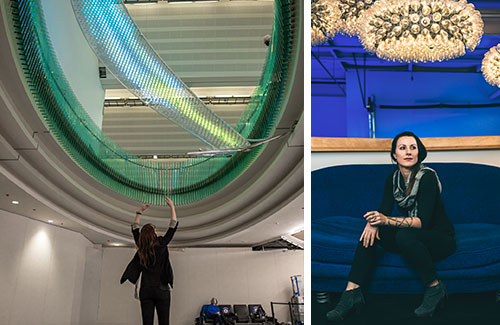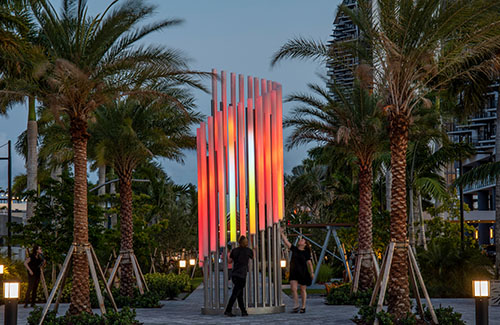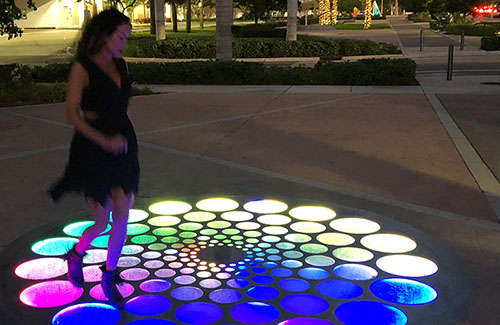Get inspired by media and interactive sculptor Jen Lewin’s inventive use of light, color and sound to draw people in to her works of art.
Major airports are made for connections. But the idea of connecting goes beyond passengers at the Minneapolis–St. Paul International Airport, where “The Aurora” — a 29-foot-tall, 720-pound sculpture installed in early 2021 (below) — connects nature, technology and humanity. Using 18,000 LEDs, the suspended sculpture by media and interactive artist Jen Lewin changes colors to reflect the seasons and live weather conditions (think oranges and reds in the fall, blues and whites on a snowy winter day). But along with reflective glass lakes on the floor below, it also changes colors and brightness levels as people interact with it. “It’s almost like creating community through art,” Lewin says. “You’re creating these rich, dynamic, connected experiences by allowing a level of interaction with sculptures at a giant scale.”
STIR tapped Lewin to learn more about how her works bring elements like light, color and sound together.

A recent installation by Jen Lewin at the Minneapolis–St. Paul International Airport, “The Aurora” (left) changes colors depending on the season and current weather conditions. Lewin sits beneath one of her “Edison Clouds,” an ongoing series of interactive sculptures (right).
Photos by Kari Jo Skogquist (left) and Chip Kalback (right), courtesy Jen Lewin Studio
Besides connecting technology with nature and humanity, your works connect different artistic and academic disciplines, too. How did all of that begin to intersect for you?
My mom was a dancer and choreographer, and my dad was a physician, so there was this interesting world of art, math and science at home. From childhood, I was crawling around a ballet studio and, until I was 18, basically in a dance studio every single day. But I also loved science — and computers, in particular — and I started taking computers apart and writing code in the third grade. Weirdly enough, computers reminded me of ballet, of the same structure of rhythm and patterning that I found in dance. And then, at the same time, I would paint and draw and make things.
If I went to college today, I would’ve gone into a mixed-media program, but no such program existed then. So, I very strategically picked architecture as a form of study. I picked it because it was in between — it allowed me to take classes in art, psychology and engineering. But this was also when computer science and computer graphics were blowing up. So I mastered 3D modeling back in the early, early days.
How did that serve as a springboard for interactive sculpture?
One of the first pieces I made was a laser harp — taking a wood harp with strings that I had built years earlier and putting colorful lasers in it. And I did all the code and hardware and learned everything from scratch.
From there, how did your work evolve to become so large in scale?
I wanted the work to be interactive, but I didn’t want people to line up and take turns pushing a button. I wanted them to have these meaningful and deep interactive experiences — almost community experiences with everyone else. So the pieces just kept getting bigger. But even as they get bigger, it’s always going to be very hands-on for me. I love building, down to writing the code. So while I have a team of five now — something we obviously need to build work of this scale — we’re all involved in every element, which is fun.

“Helix,” made up of 24 spires arranged in the shape of a nautilus shell, was installed this year in Doral, Florida. Sensors trigger the spires to change colors.
Photo by Oriol Tarridas Photography, courtesy of Jen Lewin Studio
That includes having fun creating all kinds of different colors and brightness levels. Tell us about that.
For me, it’s not just about the LED lighting and the color but about the diffusion of the LED lighting and color through a material. When I use reflective glass, for example, in the daytime there can be this ethereal quality that resembles light twinkles of blues and lightly flowing water. And then at night, it comes into this really flowing, super glowing, more intensely blue landscape. So the pieces are guided by the materiality. Whether I’m using a polypropylene molded plastic, fiberglass, clear glass or dichroic (nontranslucent) glass, the material can radically change the colors.
What else guides the colors you choose?
In each installation, especially in temporary installations, I calibrate all of the colors to work within the landscape. If I might have perceived something to be red and yellow beforehand, when it comes time to install it, I might see that the colors need to shift into the blues. And because I build all of our technology in house, it’s very easy to make those adaptations and really think about and have control over the color.

Part of a permanent art walk in Coral Springs, Florida, “Ascent” features translucent glass that softly reflects the environment during the day, then brilliantly transmits colorful light at night.
Photo courtesy Jen Lewin Studio
Sound often plays a role, too, right?
Yes, there’s a series of works, like “Andante” (shown in photo at top) and “Flow,” which aren’t just about light and color but also sound. So you have this very dramatic lighting effect that happens based on your interaction, and that then ties to sound — often in tones a lot like what you’d hear in a xylophone. And because all of that is composed fluidly together, the quality of the light and the quality of the sound are cohesive.
How do people respond to that multifaceted experience?
The quality of that moment — when you put your hand up to the piece and it’s color on your hand that’s then illuminating your face — I don’t even know how to explain it. But to me, the light and color and sound all connect. It’s sort of magical, and maybe it came from my dance background, but I want people to be part of the work, and in a meaningful way. I want to bring people in, allow them to play and let them connect with others.
What’s next for you?
I’m working on a new concept called “The Last Ocean,” a traveling ground-based piece that will look like a large ice field. It will glow and change color when you play on it, and it will travel with educational information around climate change. We want to build it out of reclaimed ocean plastic. Our colors will be determined by the colors of that plastic, and the lighting will be determined by how it refracts and glows within that material. It’s ended up being a really large engineering and sourcing feat, but it’s something I know we’ll figure out.
See more photos and a video of Jen Lewin’s work at Sherwin-Williams Design Pros on Instagram.
Photo at top by Oriol Tarridas Photography, courtesy Jen Lewin Studio; “Andante,” 2021, Doral, Florida, © Jen Lewin







